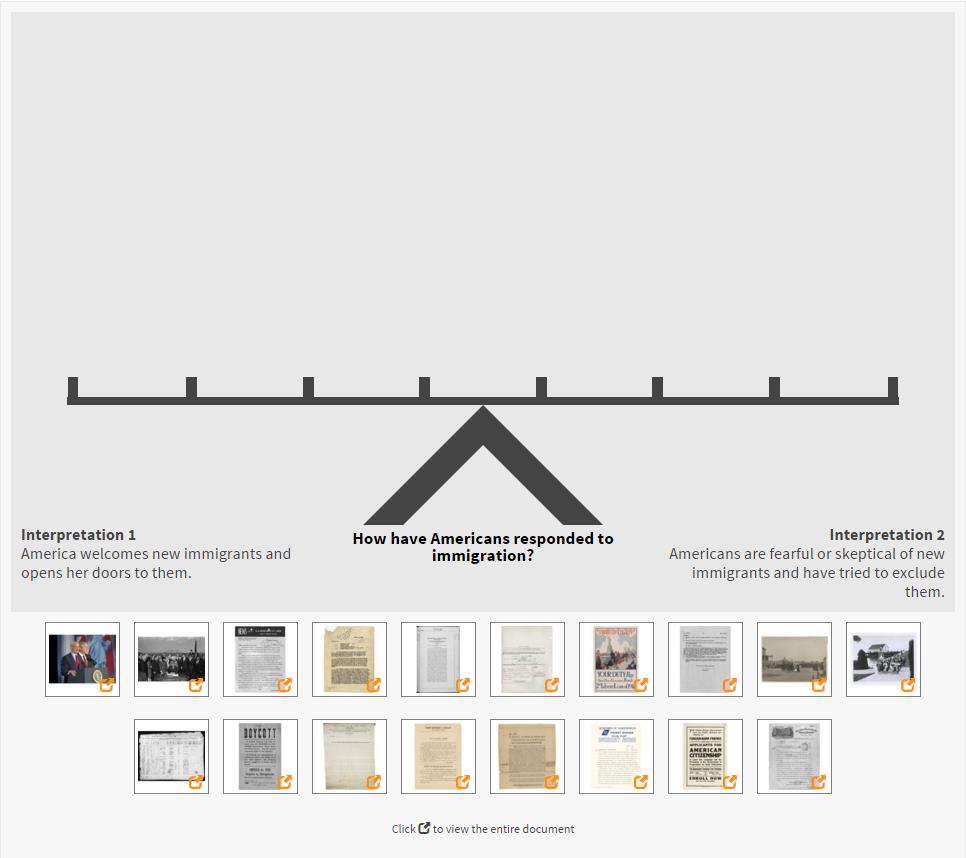 See activities created with the Weighing the Evidence tool.Select documents for students to analyze and place on a scale according to how they support one historical interpretation or another. Or ask students to arrive at their own interpretations based on the evidence.
See activities created with the Weighing the Evidence tool.Select documents for students to analyze and place on a scale according to how they support one historical interpretation or another. Or ask students to arrive at their own interpretations based on the evidence.Learning Objectives
- Formulate interpretations based upon historical evidence
- Analyze, interpret, and evaluate historical documents to determine their credibility and validity as evidence
- Understand how to combine and scaffold evidence to arrive at historical conclusions
- Understand how persuasiveness of evidence is relative based on a number of factors
To Create a Weighing the Evidence Activity:
- Go to My Activities and create a new activity.
- Choose documents to include; pull in all, or only specific, pages of a document. Add your own text. Reserve spots for student responses where they can suggest what evidence is missing. You can also upload images to include documents, photographs, or other images from sources beyond the National Archives. Decide whether students will be able to access all of the details available for the documents (including dates and descriptions) or simply the document images and titles.
- Enter the topic and the two opposing interpretations. Or leave them blank for students to fill in.
- Write instructions for your students, including an introduction and conclusion. You can include questions or a follow-up assignment in your conclusion. Students can email their responses to you if desired.
- Preview the student activity and create a snapshot.
- Lastly, describe your activity to other teachers by providing a summary. Tag it with the appropriate historical era, historical thinking skill, level of Bloom's Taxonomy, and grade level. You can also include detailed teaching instructions.
Teaching Tips
- Model document analysis with at least one document in the activity before asking students to begin placing documents on the scale. Remind students to analyze the rest of the documents carefully.
- Ask students to hypothesize about the content and persuasiveness of each document before formally beginning the activity. The exercise can act as a pre-assessment and can guide students' thinking. This establishes a purpose for viewing the documents and students will begin to contextualize them.
- Ask students to back up their opinions of where the evidence belongs on the scale verbally or in written format. This reinforces that historical interpretation should be backed by substantial evidence.
- Follow up the activity with a discussion about what it means for evidence to be strong or persuasive, with questions such as: Which documents were placed where? Why? Which documents were given greater weight? Why? What historical conclusions did you draw?
- Ask students to consider the source of information, its content, and its form. Remind students to consider their personal backgrounds and if they harbor any personal bias, as well as historical and societal impacts.
- Write in opposing historical interpretations to have students choose which interpretation they believe each document supports. Students weigh the documents as evidence in light of all of the evidence in presented.
- Or leave the interpretations blank for students to fill in. Students analyze each document in the activity and come up with two possible historical conclusions that the evidence might suggest, and place documents on the scale.
- To show how historical evidence is more or less credible depending upon its source, choose a set of documents whose creators differ and ask students to focus on the credibility of the sources. Engage the class in a follow-up discussion about why certain sources might be more convincing or reliable than others.
- To help students understand how individuals can be swayed by evidence due to its format, choose a set of records with varying formats, including written documents, photographs, and media. Ask students to reflect upon whether evidence would have been as persuading in a different format.
- Introduce primary sources to younger students with this tool to help them understand how conclusions are supported by evidence. Use simple written documents or photographs, posters, drawings or media. Fill in two basic but opposing historical interpretations. Walk students through document analysis to decipher what each document is, what it means, and if it supports a particular interpretation on the scale. Model placing documents on the scale.
Back to all tools.



